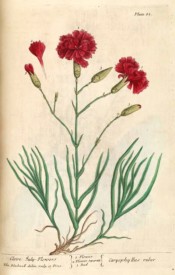Dianthus caryophyllus L.
The plant referred to here is most likely the popular plant that has been in cultivation for centuries, known as the ‘Clove pink’, ‘Carnation’ or ‘Border Carnation’. ‘Dianthus caryophyllus is considered the source whence have sprung the numerous varieties of the Carnation and the Picotee.’ [Don]. The parentage is obscure, but certainly includes Dianthus caryophyllus with D. chinensis and possibly others, depending on type and form. Half-hardy to fully-hardy, very variable perennial with characteristic lance-shaped leaves and mounded to spreading habit. The flowers, in a wide range of form and colour, are born mainly in the summer. Numerous garden cultivars exist. To 1.5m by 40cm. [RHSE, Hortus]. Picotee is a division of the Florists’ Carnation, considered separately in the Hortus because this division is further sub-divided to complicate things and there are a large number of Picotees in the record. ‘In the Florists’ Magazine for 1836 there is a concise statement upon the rules governing the Carnation. It is divided, we are told, into three sections: Flakes, Bizarres, and Picotees. Flakes have, generally, one colour on a white ground; and that colour is scarlet, purple, rose or pink. Bizarres have two colours on a white ground, and are called Scarlet or Crimson Bizarres, according to the most dominant of these two colours. The Bizarres are variegated in irregular spots or stripes. Piquettes, or Picotees, have a white ground, spotted or pounced with scarlet, red, purple, or other colours. The Picotees, it is confusing to read, are further divided into six distinct classes, red edged, maroon, chocolate, purple, rose, or scarlet edged, of each of these there being two divisions known as heavy and light edged.’ [Sitwell p.93]. See Dianthus caryophyllus L. var. Mathew’s ‘Ne Plus Ultra’ for further information on Victorian Picotees.
Horticultural & Botanical History
Before spices became easily available and affordable, particularly strongly-scented varieties, sometimes called ‘Sops-in-wine’, were used to impart flavour to food and drink, mulled ale and wine for example. They were also used medicinally in a syrup or conserve to ‘comfort the heart.’ ‘The flowers of the Clove Gillyflower or Clove Pink are used in pharmacy to give a pleasant flavour and beautiful colour to an officinal syrup. the variety which is officinal surpasses all the others in the richness of its smell; it is of a dark blood colour, with the stigmas protruding beyond the petals.’ [Don]. Curtis’s Botanical Magazine figures a scarlet bizarre carnation, ‘Franklin’s Tartar’, one of the earliest full colour depictions of a modern carnation. ‘The Carnation here exhibited is a seedling raised by Mr. Franklin, of Lambeth-Marsh, an ingenious cultivator of these flowers, whose name it bears: we have not figured it as the most perfect flower of the kind, either in form of size, but as being a very fine specimen of the sort, and one whose form and colours it is in the power of the artist pretty exactly to imitate.’ [BM t. t.39/1788]. The plant figured by Blackwell, called by her Dianthus ruber and reproduced here, appears identical with the Clove Pinks seen in gardens today. [Blackwell pl.85/1737].
History at Camden Park
Listed in all published catalogues [H.88/1843].
Notes
Published Jan 26, 2009 - 04:28 PM | Last updated Jul 16, 2010 - 02:30 PM
| Family | Caryophyllaceae |
|---|---|
| Category | |
| Region of origin | Southern Europe to India |
| Synonyms | |
| Common Name | Wild carnation |
| Name in the Camden Park Record | Dianthus caryophyllus |
| Confidence level | high |


